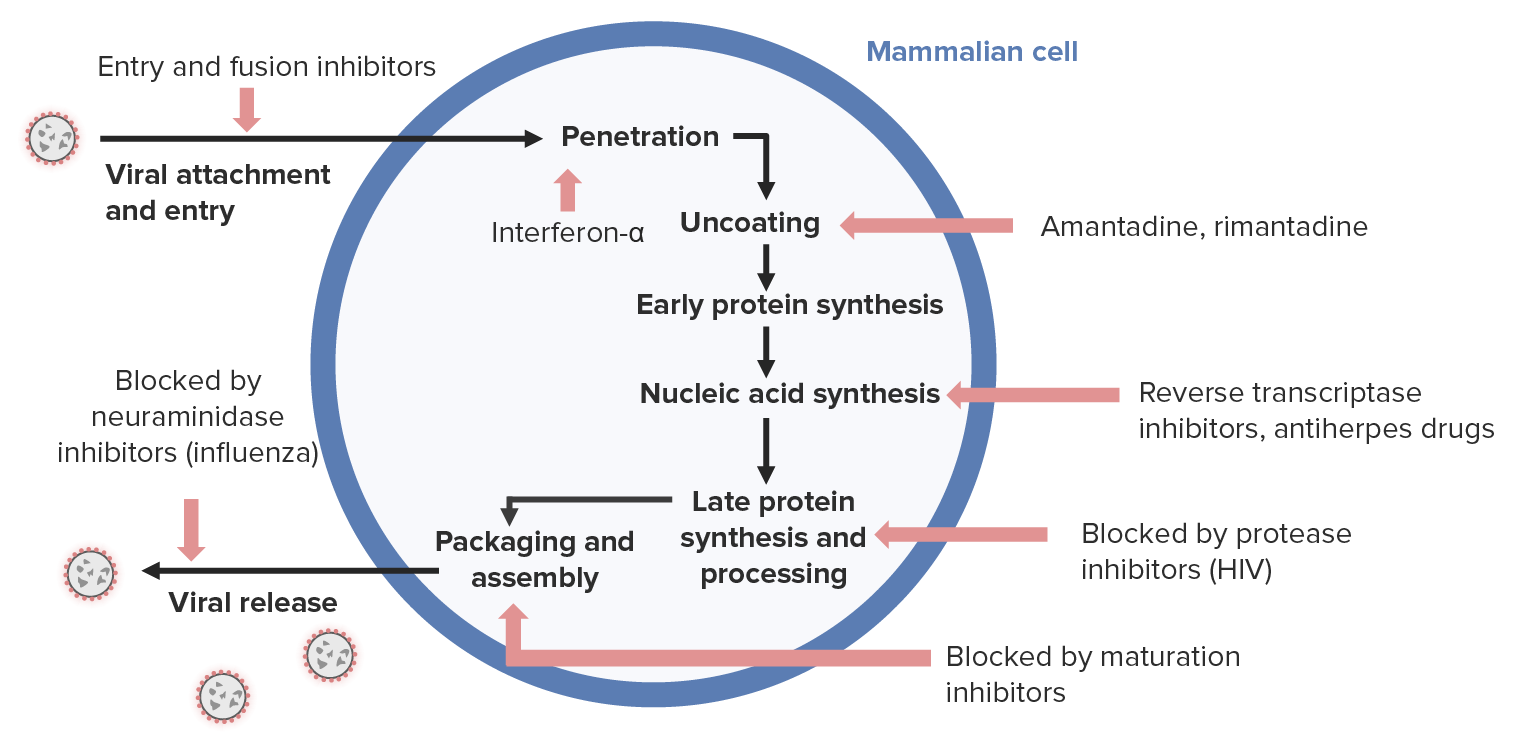Playlist
Show Playlist
Hide Playlist
Anti-Herpes Agents: Foscarnet – A pyrophosphate analog
-
Slides Anti-Herpes Agents RNA Polymerase Inhibitors.pdf
-
Reference List Pharmacology.pdf
-
Download Lecture Overview
00:01 Let's move on to the pyrophosphate analog class of antiviral drugs, which has only one member: Foscarnet. Foscarnet is unique in its mechanism of action directly targeting viral DNA polymerase, a key enzyme involved in viral DNA replication. 00:19 It achieves this by binding to the pyrophosphate binding site of the enzyme. 00:23 This binding action is critical because it blocks the cleavage of pyrophosphate from deoxynucleotide triphosphates, a necessary step for DNA chain elongation. Without this process, the viral DNA cannot be properly synthesized, effectively halting the replication of the virus. 00:42 One of the standout features of Foscarnet is that, unlike nucleoside analogs, it does not require phosphorylation by viral enzymes to become active. 00:51 This characteristic is particularly important because many antiviral resistant strains develop their resistance by mutating the enzymes responsible for phosphorylation. Since Foscarnet bypasses this step entirely, it remains effective against these resistant strains, providing a vital option when first line antiviral therapies fail. 01:12 In addition to its primary action on viral DNA, polymerase, Foscarnet also exhibits inhibitory effects on RNA polymerase and HIV reverse transcriptase. 01:23 However, it's important to note that its impact on these enzymes is less pronounced compared to its effect on DNA polymerase. 01:31 Foscarnet is primarily utilized in the treatment of ganciclovir resistant cytomegalovirus (CMV) infections, particularly in patients with Aids or in transplant recipients who are at high risk for severe viral infections due to its ability to inhibit viral replication without requiring activation by viral enzymes. 01:51 Foscarnet is a critical option in cases where other treatments have failed. 01:57 In addition to its primary use, Foscarnet is also employed off label for other CMV infections. 02:03 For the prevention of these infections in high risk patients, and to treat varicella zoster virus (VZV) in certain adult populations. Foscarnet carries significant risks, which are reflected in its U.S. boxed warnings. 02:17 The major toxicity associated with Foscarnet is renal impairment. 02:21 This can manifest as acute kidney injury, which necessitates frequent monitoring of serum creatinine levels. 02:28 It is crucial to adjust the dosage in response to any changes in renal function, and to ensure that the patient is adequately hydrated during treatment to minimize the risk of nephrotoxicity. 02:40 Another serious risk is seizures, which are linked to alterations in plasma minerals and electrolytes such as hypokalemia, hypocalcemia, hypomagnesemia, and hypophosphatemia. 02:53 These electrolyte disturbances can lead to severe neurological complications. Therefore, careful monitoring of electrolyte levels is essential and supplementation may be required to prevent or manage these changes. 03:07 Foscarnet is specifically indicated by the FDA for use in immunocompromised patients, such as those with CMV retinitis or mucocutaneous. 03:16 Acyclovir. Resistant herpes simplex virus. 03:18 (HSV) infections. Due to its potential for severe adverse effects. 03:23 Foscarnet should be reserved for cases where it is clearly indicated and where other antiviral agents are ineffective, while foscarnet is also used off label. 03:33 In some situations, it is important to ensure that such use is supported by clinical evidence that informed consent is obtained from the patient, and that the treatment is in the patient's best interest. 03:44 Off label drug use can be a necessary and life saving practice, but it must be approached with caution and responsibility. 03:52 Other adverse effects include headache, gastrointestinal disturbances, (nausea, diarrhea, vomiting), anemia, granulocytopenia, and fever. 04:03 Genitourinary ulceration can also occur in patients who are on foscarnet as well. The mechanism is likely related to the presence of foscarnet in the urine, which can cause local mucocutaneous toxicity.
About the Lecture
The lecture Anti-Herpes Agents: Foscarnet – A pyrophosphate analog by Pravin Shukle, MD is from the course Antimicrobial Pharmacology.
Included Quiz Questions
Foscarnet is characterized by...? (Select all that apply).
- ...not requiring phosphorylation to be active.
- ...acting as an antimetabolite.
- ...being a pyrimidine analogue.
- ...being able to inhibit DNA polymerase in acyclovir-resistant viruses.
- ...possibly causing nephrotoxicity and gastrointestinal ulceration.
Customer reviews
5,0 of 5 stars
| 5 Stars |
|
5 |
| 4 Stars |
|
0 |
| 3 Stars |
|
0 |
| 2 Stars |
|
0 |
| 1 Star |
|
0 |




